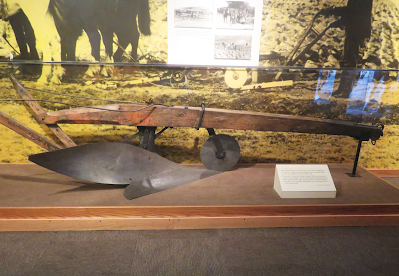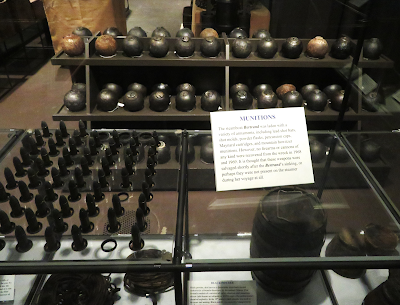During our family visits to Omaha, we’ve continued to explore the state of Nebraska as well as the Omaha metropolitan area itself. The De Soto National Wildlife Refuge and its museum was one more attraction on our Omaha area’s ‘to visit list’. So the family headed a little north of Omaha and then across the Missouri River into Iowa.
The large building that is so nicely blended into the trees is the Refuge Office and Museum for the DeSoto National Wildlife Museum. Parts of this 8,365 acre wildlife refuge lie in both Iowa and Nebraska but the largest portion, including this structure, is located in Iowa. The refuge is centered on DeSoto Lake, an oxbow lake that was once a bend in the Missouri River.
This
refuge includes bottomland forests, tall grass prairie and wetland habitats
that mimic the natural Missouri River floodplain. One of, if not the primary purpose, for the
DeSoto National Wildlife Refuge’s existence is that it serves as a critical
flyway stopover for migrating birds that pass through here each spring and
fall.
This
handsome sculpture of an eagle near the entrance to the Refuge office and
museum was created by Richard Hart in 2003.
It was paid for by visitors to the Refuge as well through donations.
Exhibits
related to the wildlife found at the DeSoto National Wildlife Refuge are found near
the entrance to the Refuge’s office.
There are a number of taxidermy examples that provide visitors with
close-up looks at various species. The
combination of habitats in the refuge is utilized by more than 100 species of
birds… Of course, we visited in mid-summer so other than a few water birds and
local feathered residents, birdwatching was minimalized. The Refuge is also home to rabbits, mink,
muskrat, beaver, otters, white-tailed deer, bobcat, coyotes and many other mammals.
As we
moved past the taxidermy birds and other animals, we noted this steel
plow. Once upon a time, the USA’s
tallgrass prairie land covered about 170,000,000 acres or 40% of the
country. Somewhere from 1 to 4%
remain.
The soil
in the tallgrass prairie was rich in nutrients and steel plows enabled European
American settlers to break up the rich sod and plant crops. The layers were so deep that it required a
special ‘breaking plow’ to plow a furrow the first time. Those plows were attached to a cart that was
pulled by a yoke of 4 – 6 oxen.
Next, we
came to the part of the museum that isn’t related to wildlife…but rather man’s
movement to the western USA in the 1800s. The ship model is of the ‘Bertrand’, a
stern-wheel steamboat. It was built in
Wheeling West Virginia in 1864. The ship
was 161 feet long and had a beam/width of 32 feet. She was a shallow draft vessel, probably
requiring than about 3 feet of water to navigate.
The
Bertrand was one of many vessels involved in the regional river trading system
that existed from the mid to late 1800s.
Beginning in 1859, steamboats had been traveling up the Missouri River
as far as Fort Benton in the Montana Territory, which is only about 40 miles
from Great Falls. When gold was found at
the Alder Gulch claim in 1863, many wishful prospectors headed to the area from
around the country. This migration
created one of our most previously prosperous frontier towns, Virginia City
Montana. A year after the discovery,
35,000 people lived within 10 miles of the original claim.
On April
1, 1865, the Bertrand’s short career was ended when she struck a snag and sank
on her way up the Missouri River toward Fort Benton Montana. She sank in 10 minutes in about 12 feet of water and no one
lost their lives but almost the entire cargo was lost. This happened just 25 miles north of Omaha. The equivalent loss in today’s dollars was
ca. $1,900,000.
Using
historical documents and a flux gate magnetometer, 2 modern treasure hunters
located the wreck of the Bertrand in early 1968. As the wreck was found on Federal property,
the treasure hunters relinquished all of the recovered artifacts to the U.S.
Fish and Wildlife Service for permanent preservation. More than 500,000 artifacts were recovered
during the excavation.
The items
shown in the photo above are “carboys”, lead containers used to transport
mercury. The treasure hunters had hoped
to find the rumored 500 of these containers on the wreck, but only 9 were ever
found. The mercury in 500 of these
containers would have been very valuable.
FYI – When
mercury and gold meet, they settle and combine to form an amalgam. Then the gold is extracted by vaporizing the
mercury…a highly toxic procedure but common in the gold rush days.
This photo shows a variety of items on exhibit in the Bertrand portion of the museum. On the shelves behind the bottles are wash tubs, lard tins, and champagne. The bottles contain a variety of food items. The vessel’s cargo included 216 pints of honey plus strawberries, pepper sauce, bourbon, brandy, vegetables, peaches, etc.
Early ‘canned
goods’ were stored in sealed glass containers.
Sanitary air-tight cans weren’t introduced until 1904. Samples of canned food from the Bertrand,
including brandied peaches, oysters, plum tomatoes, honey and mixed vegetables
were tested in 1974. Appearance, smell
and the vitamin content has deteriorated, but the food was determined to still
be safe to eat. No thank you!
What
follows is a series of photos showing a fraction of the cargo that has been recovered
from the Bertrand and preserved. In the
photo above, there are doorknobs, brass drawer pulls, padlocks and hinges…with
that big roll of hemp in the background.
This is a
solid wood box full of axe heads.
Interesting irony…the crate is labeled with the warning, “Must be kept
Dry”. Other key items for the miners
included blasting powder, pickaxes and bunches of shovels. I believe that the same disclaimer probably applied to similar boxes...that contained soap.
As the
sign on this display states, cowbells would have been valuable in the Montana
Territory, especially during the gold rush.
It was a chance to get rich without mining! Dairy cows were really valued by the mining camps
for their milk, cream and butter.
It boggles my mind that textiles survived in their containers under the mud and water for over 100 years before they were ‘recovered’. Here we have a selection of hats and socks…along with surviving fabric and a tie. Over 3,000 textile and items of clothing were recovered. They included gloves, trousers and 137 men’s coats in a number of different styles.
Did you notice the ice skates and wooden buckets in the first photo above?
Being the
‘wild west’ in 1865, and right after the Civil War, the Bertrand was also fully
loaded with munitions although no firearms or cannons were recovered in 1968 –
1969. It is thought that either there
weren’t any on the vessel when it went down or that they were salvaged
immediately after the ship was wrecked.
In any case, the recovered munitions include lead shot bars, shot molds,
powder flasks, percussion caps and even mountain howitzer shells.
Just in
case you were wondering…all of the goods on the Bertrand were fully
insured.
Although the ‘star’ of our visit was the contents of the Bertrand, the purpose of the refuge is its wildlife. While we didn’t seen many water birds, there were plenty of songbirds and we did spots lots of turtles. I noted that related species at the DeSoto National Wildlife Refuge include: smooth soft shelled; spiny soft shelled; painted; Blanding’s; ornate box, and; snapping turtles.
To learn
more about the DeSoto National Wildlife Refuge and its museum, go to DeSoto National Wildlife Refuge | U.S. Fish & Wildlife
Service (fws.gov).
Admission: $3.00 per vehicle or via a National Park Pass! It’s quite a deal given how much most
attractions cost in this day and age…
To learn
about an even earlier steamboat wreck on the Missouri River (1856), the story
of its discovery in 1988 and the preservation of associated items, you can just
journey to Kansas City and visit the museum for the steamboat Arabia. See A Historic Kansas City
Attraction | The Arabia Steamboat Museum (1856.com).
Just
click on any of the photos to enlarge them…
Thanks
for stopping by for a visit!
Take
Care, Big Daddy Dave















I always can count on you showing us some interesting stuff. I have absolutely no idea about the early canning wares. Those glasses are so tiny....might be good for alcohol, but for food?
ReplyDeleteThose turtles look cute!
Lindo refugio. Me gusto la escultura. Te mando un beso.
ReplyDeleteStrange to go to a wildlife preserve and see mainly the artifacts from a steam boat wreckage...and all those turtles! But interesting anyway!
ReplyDeleteLooks to be an interesting place to visit. Hard to believe how big the prairie was and how little remains.
ReplyDelete